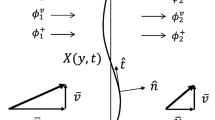Abstract
Results of an experimental study of the laminar-turbulent transition in a hypersonic flow around cones with different bluntness radii at a zero angle of attack, free-stream Mach number M ∞ = 6, and unit Reynolds number in the interval Re ∞,1 = 5.79 · 106–5.66 · 107 m−1 are presented. Flow regimes in which a reverse of the laminar-turbulent transition (decrease in the length of the laminar segment with increasing bluntness radius) are studied. Heat flux distributions over the model surface are obtained with the use of temperature-sensitive paints. Lines of the beginning of the transition in the boundary layer are analyzed by using heat flux fields. The critical Reynolds number Re ∞,R ≈ 1.3 · 105 beginning from which the laminar-turbulent transition substantially depends on uncontrolled disturbances, such as the model tip roughness, is found. In supercritical regimes, the line of the transition beginning is shifted in most cases toward the model tip (reverse of the transition). The results obtained are compared with available experimental data.
Similar content being viewed by others
References
X. Zhong, “Numerical Simulation of Hypersonic Boundary Layer Receptivity and Stability on Blunt Circular Cones,” AIAA Paper No. 2009-0940 (2009).
X. Zhong and J. Lei, “Numerical Simulation of Nose Bluntness Effects on Hypersonic Boundary Layer Receptivity to Freestream Disturbances,” AIAA Paper No. 2011-3079 (2011).
E. Reshotko and A. Tumin, “The Blunt Body Paradox — a Case for Transient Growth,” in Laminar-Turbulent Transition: Proc. of the Int. Union of Theoretical and Applied Mechanics Symp., Sedona, September 13–17, 1999 (Springer-Verlag, Berlin, 2000), pp. 403–408.
M. R. Malik, R. E. Spall, and C. L. Chang, “Effect of Nose Bluntness on Boundary Layer Stability and Transition,” AIAA Paper No. 90-0112 (1990).
I. Rosenboom, S. Hein, and U. Dallmann, “Influence of Nose Bluntness on Boundary-Layer Instabilities in Hypersonic Cone Flows,” AIAA Paper No. 99-3591 (1999).
J. Lei and X. Zhong, “Linear Stability Study of Hypersonic Boundary Layer Transition on Blunt Circular Cones,” AIAA Paper No. 2009-939 (2009).
K. F. Stetson and R. L. Kimmel, “On Hypersonic Boundary-Layer Stability,” AIAA Paper No. 92-0737 (1992).
E. J. Softley, “Boundary Layer Transition on Hypersonic Blunt, Slender Cones,” AIAA Paper No. 69-705 (1969).
A. S. Gaponov and A. A. Malov, Development of Disturbances in Compressible Flows (Nauka, Novosibirsk, 1980) [in Russian].
S. P. Schneider, “Hypersonic Laminar-Turbulent Transition on Circular Cones and Scramjet Forebodies,” Progr. Airspace Sci. 40(1/2), 1–50 (2004).
K. F. Stetson, “Nosetip Bluntness Effects on Cone Frustum Boundary Layer Transition in Hypersonic Flow,” AIAA Paper No. 83-1763 (1983).
K. F. Stetson and G. H. Rushton, “Shock Tunnel Investigation of the Boundary Layer Transition at M = 5.5,” AIAA J. 5, 899–906 (1967).
L. E. Ericsson, “Effects of Nose Bluntness and Cone Angle on Slender Vehicle Transition,” AIAA Paper No. 87-1415 (1987).
S. P. Schneider, “Flight Data for Boundary-Layer Transition at Hypersonic and Supersonic Speeds,” J. Spacecraft Rockets 36(1), 8–20 (1999).
V. Borovoy, V. Mosharov, A. Noev, and V. Radchenko, “Temperature Sensitive Paint Application for Investigation of Boundary Layer Transition in Short-Duration Wind Tunnels,” Progr. Flight Phys. 3, 15–24 (2012).
R. G. Batt and H. H. Legner, “A Review of Roughness-Induced Nosetip Transition,” AIAA J. 21(1), 7–22 (1983).
Author information
Authors and Affiliations
Corresponding author
Additional information
Original Russian Text © E.A. Aleksandrova, A.V. Novikov, S.V. Utyuzhnikov, A.V. Fedorov.
__________
Translated from Prikladnaya Mekhanika i Tekhnicheskaya Fizika, Vol. 55, No. 3, pp. 5–16, May–June, 2014.
Rights and permissions
About this article
Cite this article
Aleksandrova, E.A., Novikov, A.V., Utyuzhnikov, S.V. et al. Experimental study of the laminar-turbulent transition on a blunt cone. J Appl Mech Tech Phy 55, 375–385 (2014). https://doi.org/10.1134/S0021894414030018
Received:
Published:
Issue Date:
DOI: https://doi.org/10.1134/S0021894414030018




